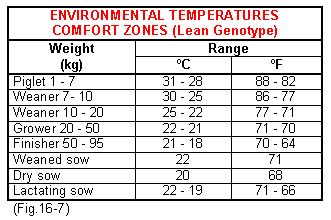



The health and welfare of weaned and growing pigs
Design requirements
Weaned and growing pigs are usually group-housed in pens of 5 to 200 pigs per pen..
Size - This is dependent on the numbers of pigs per pen, their weight, the type of floor surface, the bedding used if any and the shape of the pen. Fig.16-1 gives guidelines to stocking density requirements on either solid or part slatted systems.
Floors - These can be totally solid, insulated and drained towards the defecating area, part solid and part slatted, totally slatted or straw based. If the quality of the slats is good and they have a round edge, a totally slatted area provides the best performance and welfare conditions provided that the temperature, air flow and humidity are controlled within the pigs' requirements. Welfare codes favour bedding but for this to be satisfactory it must be available, clean, dry and deep enough to provide warmth and comfort. This is often not the case and pigs are better without it.
Water - This can be provided either through nipple drinkers, automatic bowls or troughs. The water requirements for pigs are given in Figs.16-4 to 16-6. Water should be available at all times.
Feed - This can be presented to the pig by a wet feeding system three to four times daily, restricted feeding or ad libitum through feed hoppers. Wet feeding systems have several advantages. Within a group all pigs tend to drink at about the same speed whereas there is a wide variation between pigs in the amounts of dry feed they can eat. Feeding space requirements are shown in Fig.16-3.
Group size - The optimum size varies depending upon the type of system and the availability of feed. For example in indoor totally slatted pens 20 pigs may be the maximum for efficient production. In straw yards this could rise to 60 pigs or more per pen.
Temperature - A guide to requirements is given in Fig.16-7 but always adjust to maintain the pigs in a comfortable lying pattern.
Management, welfare and disease
If the pigs' requirements are not satisfied, disease problems are created particularly if a catabolic state develops. Housing should be managed on an all-in all-out basis with a total depopulation, cleaning and disinfection between groups. This is important for both respiratory and enteric disease control.
Reduced feed availability, lower temperatures or poor quality food will also lead to stress and an increased predisposition to enteric and/or respiratory disease as well as behavioural abnormalities.










